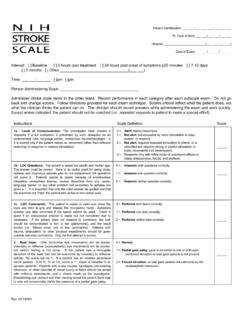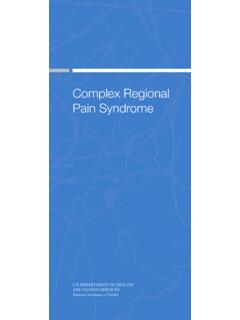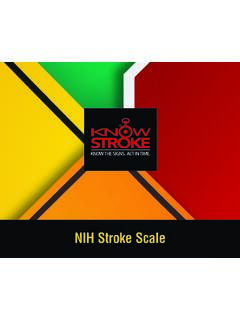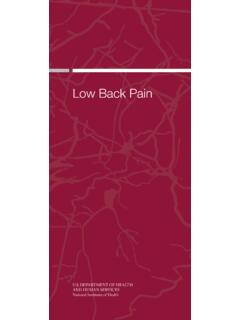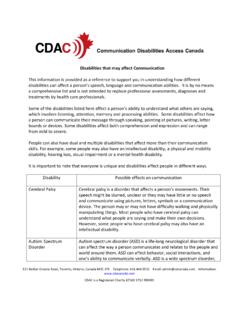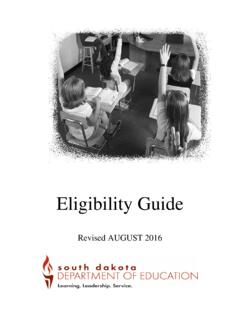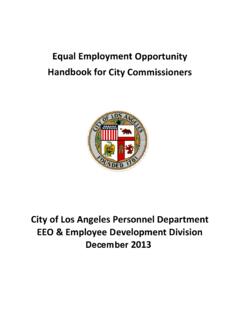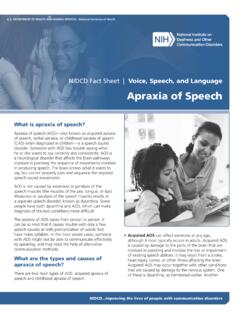Transcription of NIH Stroke Scale
1 NIH Stroke ScaleAdminister Stroke Scale items in the order listed. Record performance in each category after each subscale exam. Do not go back and change scores. Follow directions provided for each exam technique. Scores should reflectwhat the patient does, not what the clinician thinks the patient can do. The clinician should record answers whileadministering the exam and work where indicated, the patient should not be coached ( , repeatedrequests to patient to make a special effort).InstructionsLevel of Consciousness: The investigator must choose a response if a full evaluation is prevented by such obstacles as an endotracheal tube, languagebarrier, orotracheal trauma/bandages. A 3 isscored only if the patient makes no movement(other than reflexive posturing) in response tonoxious Definition Level of Consciousness0 Alert;keenly alert;but arousable by minor stimulation to obey, answer, or alert; requires repeated stimulation to attend, or is obtunded and requires strong or painful stimulation to make movements (not stereotyped).
2 3 Responds only with reflex motor or autonomic effects, or totally unresponsive, flaccid, and Questions: The patient is asked the month and his/herage. The answer must be correct there isno partial credit for being close. Aphasic andstuporous patients who do not comprehend the questions will score 2. Patients unable to speak because of endotracheal intubation, orotracheal trauma, severe dysarthria from anycause, language barrier, or any other problemnot secondary to aphasia are given a 1. It is important that only the initial answer begraded and that the examiner not help thepatient with verbal or non-verbal Definition Level of Consciousness0 Answers both questions one question neither question Commands: The patient is asked to open and close the eyes and then to grip and release the non-paretic hand. Substitute another one-step command if the hands cannot be used. Credit is given if an unequivocal attempt is made but not completed due to weakness.
3 If the patient does not respond to command, the task should be demonstrated to him or her (pantomime), and the result scored( , follows none, one, or two commands).Patients with trauma, amputation, or other physical impediments should be given suitable one-step commands. Only the first attempt is Definition Level of Consciousness0 Performs both tasks one task neither task Gaze: Only horizontal eye movements will be or reflexive (oculocephalic) eyemovements will be scored, but caloric testing is not done. If the patient has a conjugatedeviation of the eyes that can be overcome by voluntary or reflexive activity, the score will be 1. If a patient has an isolated peripheral nerve paresis (CN III, IV, or VI),score a 1. Gaze is testable in all aphasicpatients. Patients with ocular trauma, bandages, pre-existing blindness, or other disorder of visual acuity or fields should betested with reflexive movements, and a choicemade by the investigator. Establishing eyecontact and then moving about the patientfrom side to side will occasionally clarify thepresence of a partial gaze Definition Best gaze palsy;gaze is abnormal in one or both eyes, but forced deviation or total gaze paresis is not deviation, or total gaze paresis is not overcome by the oculocephalic : Visual fields (upper and lower quadrants) aretested by confrontation, using finger countingor visual threat, as appropriate.
4 Patients maybe encouraged, but if they look at the side ofthe moving fingers appropriately, this can be scored as normal. If there is unilateralblindness or enucleation, visual fields in theremaining eye are scored. Score 1 only if aclear-cut asymmetry, including quadrantanopia,is found. If patient is blind from any cause,score 3. Double simultaneous stimulation isperformed at this point. If there is extinction,patient receives a 1, and the results are used to respond to item Definition Visual0No visual hemianopia (blind includingcortical blindness).3 InstructionsScoreScoreFacial Palsy:Ask or use pantomime to encourage thepatient to show teeth or raise eyebrows andclose eyes. Score symmetry of grimace inresponse to noxious stimuli in the poorlyresponsive or non-comprehending patient. If facial trauma/bandages, orotracheal tube,tape, or other physical barriers obscure the face, these should be removed to theextent Definition Facial Palsy0 Normal symmetrical paralysis (flattened nasolabial fold, asymmetry on smiling).
5 2 Partial paralysis (total or near-total paralysis of lower face).3 Complete paralysis of one or both sides (absence of facial movement in the upper and lower face).4 InstructionsMotor Arm:The limb is placed in the appropriate position:extend the arms (palms down) 90 degrees (if sitting) or 45 degrees (if supine). Drift isscored if the arm falls before 10 seconds. Theaphasic patient is encouraged using urgency in the voice and pantomime, but not noxiousstimulation. Each limb is tested in turn,beginning with the non-paretic arm. Only in the case of amputation or joint fusion atthe shoulder, the examiner should record thescore as untestable (UN) and clearly write theexplanation for this Arm5 InstructionsScale Definition Score5a5bScoreScoreLeft ArmRight Arm0No drift; limb holds 90 (or 45) degrees for full 10 ;limb holds 90 (or 45) degrees, but drifts down before full 10 seconds; does not hit bed or other effort against gravity;limb cannot get to or maintain (if cued) 90 (or 45) degrees, drifts down to bed, but has some effort against effort against gravity;limb joint fusion, explain:UNMotor Leg:The limb is placed in the appropriate position:hold the leg at 30 degrees (always testedsupine).
6 Drift is scored if the leg falls before5 seconds. The aphasic patient is encouragedusing urgency in the voice and pantomime butnot noxious stimulation. Each limb is testedin turn, beginning with the non-paretic in the case of amputation or joint fusionat the hip, the examiner should record thescore as untestable (UN) and clearly write theexplanation for this Leg6 InstructionsLimb Ataxia: This item is aimed at finding evidence of aunilateral cerebellar lesion. Test with eyesopen. In case of visual defect, ensure testingis done in intact visual field. The finger-nose-finger and heel-shin tests are performedon both sides, and ataxia is scored only if present out of proportion to weakness. Ataxiais absent in the patient who cannot under-stand or is paralyzed. Only in the case ofamputation or joint fusion, the examinershould record the score as untestable (UN) and clearly write the explanation for thischoice. In case of blindness, test by havingthe patient touch nose from extended armposition.
7 Scale Definition Limb in one in two joint fusion, explain: 7 InstructionsScale Definition Score6a6bScoreScoreLeft LegRight Leg0No drift; leg holds 30-degree position for full 5 ; leg falls by the end of the 5-second period but does not hit the effort against gravity;leg falls to bed by 5 seconds but has some effort against effort against gravity;leg falls to bed joint fusion, explain: UNUNS ensory: Sensation or grimace to pinprick when tested,or withdrawal from noxious stimulus in theobtunded or aphasic patient. Only sensoryloss attributed to Stroke is scored as abnormaland the examiner should test as many body areas [arms (not hands), legs, trunk, face] as needed to accurately check for hemisensoryloss. A score of 2, severe or total sensoryloss, should only be given when a severe or total loss of sensation can be clearly demonstrated. Stuporous and aphasic patientswill, therefore, probably score 1 or 0. Thepatient with brainstem Stroke who has bilateralloss of sensation is scored 2.
8 If the patientdoes not respond and is quadriplegic, score in a coma (item 1a=3) are automati-cally given a 2 on this item. Scale Definition Sensory0 Normal; no sensory sensory loss; patient feels pinprick is less sharp or is dull on the affected side; or there is a loss of superficial pain with pinprick, but patient is aware of being or total sensory loss; patient is not aware of being touched in the face, arm, and Language: A great deal of information about comprehension will be obtained during thepreceding sections of the examination. Forthis Scale item, the patient is asked todescribe what is happening in the attachedpicture, to name the items on the attachednaming sheet, and to read from the attachedlist of sentences. Comprehension is judgedfrom responses here, as well as to all of thecommands in the preceding general neurologicalexam. If visual loss interferes with the tests,ask the patient to identify objects placed inthe hand, repeat, and produce speech.
9 Theintubated patient should be asked to patient in a coma (item 1a=3) will automatically score 3 on this item. The examinermust choose a score for the patient with stuporor limited cooperation, but a score of 3 shouldbe used only if the patient is mute and followsno one-step Language9 InstructionsScale Definition ScoreScore0No aphasia ; aphasia ; some obvious loss of fluency or facility of comprehension, without significant limitation on ideas expressed or form of expression. Reduction of speech and/or comprehension, however, makes conversation about provided materialsdifficult or impossible. For example, in conversation about provided materials, examiner can identify picture or naming cardcontent from patient s aphasia ; all communication is through fragmentary expression; great need for inference, questioning, and guessing by the listener. Range of information that can be exchanged is limited; listener carries burden of communication. Examiner cannot identify materials provided from patient , global aphasia ; no usable speech or auditory : If patient is thought to be normal, an adequate sample of speech must be obtainedby asking patient to read or repeat words fromthe attached list.
10 If the patient has severe aphasia , the clarity of articulation of spontaneous speech can be rated. Only if thepatient is intubated or has other physical barriers to producing speech, the examinershould record the score as untestable (UN) andclearly write the explanation for this not tell the patient why he/she is Definition dysarthria; patient slurs at least some words and, at worst, can be understood with some dysarthria; patient s speech is so slurred as to be unintelligible in the absence of or out of proportion to any dysphasia, or or other physical barrier,explain:10 InstructionsExtinction and Inattention (formerly Neglect):Sufficient information to identify neglect maybe obtained during the prior testing. If thepatient has a severe visual loss preventingvisual double simultaneous stimulation, andthe cutaneous stimuli are normal, the score isnormal. If the patient has aphasia but doesappear to attend to both sides, the score isnormal. The presence of visual spatial neglector anosagnosia may also be taken as evidenceof abnormality.
